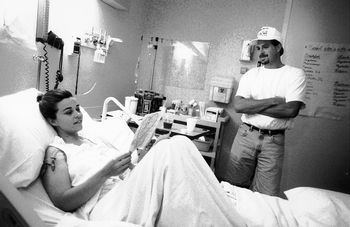VUMC's 200th liver transplant recipient making quick recovery

Robyn Wilkins, VUMC's 200th liver transplant patient, and her husband, Shayne, look over get-well cards made by the couple's children. (Photo by Donna Jones Bailey)
Vanderbilt University Medical Center's Liver Transplant program reached another milestone by performing its 200th transplant recently.
The recipient was Robyn Wilkins, a 29-year-old mother of two from Benton, Ky.
The eight-year-old transplant program began in 1991 under the direction of Dr. C. Wright Pinson, professor and vice-chairman of Surgery and surgical director of the Vanderbilt Transplant Center.
Making a speedy recovery, Wilkins was discharged from the hospital to the nearby Med Center Inn just four days after receiving her new liver.
"Everybody calls me the Wonder Transplant Woman," she said. The average stay for a liver transplant recipient is 10 days.
Wilkins was diagnosed with epitheliod hemangioendothelioma (EHE) early this year after experiencing pain in her right side for several months. According to Pinson, EHE is a rare form of cancer that begins in the patient¹s liver and, if left untreated, spreads to the lungs, lymph nodes and bones.
"In Robyn¹s case there is no indication of metastasis. We are very hopeful that we have cured her with this transplant," he said.
Prior to her transplant, Wilkins underwent three rounds of chemoembolization by Drs. Steven G. Meranze, associate professor of Radiology and Radiological Sciences, and Murray J. Mazer, associate professor of Radiology and Radiological Sciences, with the medication injected directly into the liver through a catheter.
"I would be here at the hospital for about two or three days after one of the chemo treatments and then go home to recover for about two weeks," she said. "It¹s tough, you¹re really sick after the treatments."
Wilkins had just undergone the first round of IV chemotherapy in another series of treatments the day before she got the call about her new liver. "At 10 o¹clock Thursday morning Dr. Pinson called and asked how quickly I could be here," she said.
"Everything happened right at once. We got here from Benton in about three hours. When we walked into the hospital my husband went to the admitting office and I was taken upstairs to the holding area where about fifteen or twenty people were standing there looking at me and waiting to get to work. All this happened much quicker than I thought."
Wilkins¹ diagnosis had revealed multiple tumors in her liver, eliminating the option of partial removal of the diseased organ.
"Dr. Pinson has been great. He helped me decide that a new liver would be my best option," she said. "I¹m glad I went ahead with the transplant. I¹m a wife and mother of two young children and I couldn¹t see having to go through a resection and then having to undergo a transplant several years from now."
The team performing the procedure was led by Pinson and Dr. J. Kelly Wright, associate professor of Surgery in Hepatobiliary Surgery and Liver Transplantation. Also involved in Wilkins¹ care are Dr. William C. Chapman, assistant professor of surgery in Hepatobiliary Surgery and Liver Transplant, Dr. Ellen B. Hunter, assistant professor of Medicine in Gasteroenterology, and transplant coordinators Jerita Payne and Cynthia VanGoor.
Since the Liver Transplant Program¹s inception in 1991 the number of transplants performed each year has increased steadily, with patient survival rates of 86 percent for one year, and 82 percent for two to five years post-surgery. Last year alone the program performed 45 transplants, a 22 percent increase over the 37 procedures performed in 1996. With the addition of the Liver Transplant Program, VUMC gained the distinction of being the only medical center in Tennessee to offer all major organ transplants.
In 1993 the Liver Transplant Program entered into an agreement with the Veterans Administration Medical Center to provide liver transplantation to veterans in the Southeast. By the end of 1997 the program had transplanted 51 patients.
"It takes a lot of work and a lot of resources, and there have been many people from all parts of the medical center who have contributed to the success of the program here," Pinson said. "The whole hepatobiliary multidisciplinary effort including Radiology, Hepatology, GI Oncology, and Surgery is well established as one of the premier programs in the country.
"It¹s an accomplishment we can all be proud of to go from no program to one of the best in the nation in eight years."
At press time, the Liver Transplant Program had completed its 204th transplant.













